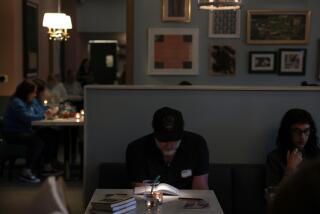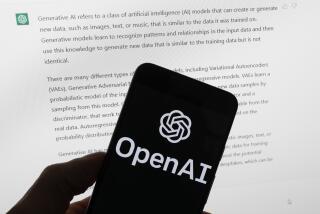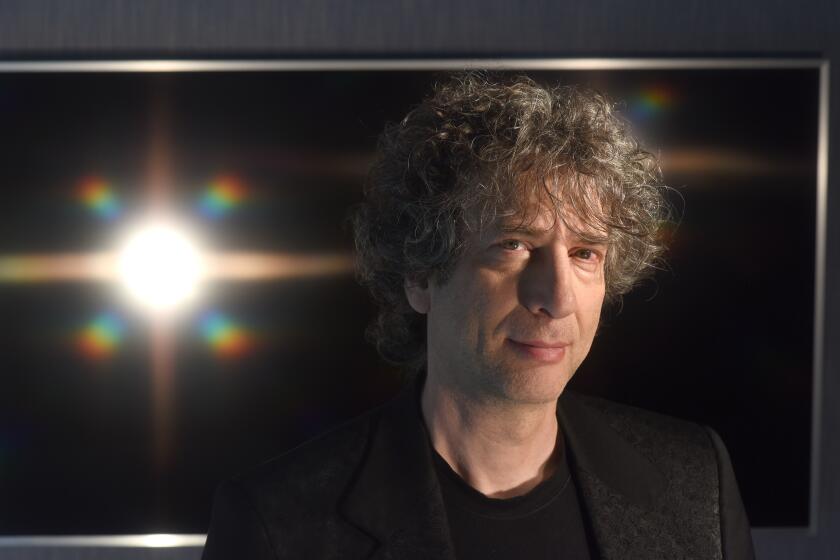Book Bytes : Are You Ready to Curl Up With a Good Computer Screen?
- Share via
A bagel in one hand, a mug of coffee in the other, Bob Stein slouches on a couch reading “Alice in Wonderland”--casually, comfortably. It’s all familiar and easy, just like paging through a book--which Stein is pointedly demonstrating.
But Stein isn’t reading the kind of paper-and-ink contraption Lewis Carroll originally wrote, its pages piled and bound together. The literary opus in his lap appears on a sleek portable computer. It is, Stein proclaims, the first electronic book.
For software wizards, the electronic book represents the start of a publishing revolution, a move from the realm of fonts and onionskin to megabytes and hypertext. With the screen, they claim, the era of Gutenberg is entering its twilight years, and reading will never really be the same.
“We’re trying to replace the printing press in a serious way,” declares Theodor Holm Nelson, a distinguished fellow at Apple Computer and a pioneer of the new technology.
Nelson and other visionaries picture a brave new world of electronic publishing, complete with electronic “bookstores” and libraries. Books, they predict, will be encoded on a piece of plastic the size of a credit card, and authors will not be restricted merely to words.
The first great American electronic novel may be created with sound effects, background music, pictures and graphics, all incorporated into the narrative.
Already, companies are experimenting with the new technology.
In November, Sony Corp. of America introduced the Data Discman, a $550 hand-held device with a keyboard and a 3.5-inch screen that allows users to consult reference and guide books produced on small discs.
But The Voyager Co. in Santa Monica, in which Stein is a partner, is the first to link electronics with serious reading.
This week the company is publishing Martin Gardner’s annotated version of “Alice in Wonderland,” Douglas Adams’ “The Hitchhiker’s Guide to the Galaxy” and Michael Crichton’s technological parable, “Jurassic Park.” The firm also plans to bring out up to 50 more titles during the year.
Available through mail order as well as selected computer and book stores, the initial offerings, contained on floppy disks, are priced at $19.95 each, while the Macintosh Bookpower computer sells for up to $4,600.
Still, will book lovers really abandon their old library companions for a keyboard and screen? Will pipe-smoking scholars converse on the megabytes in Proust and random-access Shakespearean soliloquies?
Some book buffs are already balking. “It’s a gadget that holds words,” harrumphs Doug Dutton, owner of Dutton’s bookstores, some of the city’s most venerable literary institutions. “For me a book is something that has a spine and a binding and is something you feel.”
Dutton nonetheless will carry the electronic book on a trial basis. When representatives from Voyager brought the “book” in, a fascinated crowd of customers gathered around.
“These were all people standing in a bookstore with books under their arms,” Dutton dourly observes.
But there will always be people who will want to read the old bound book, though Nelson envisions the practice as darkly archaic (“We still carve on stones in graveyards”).
Technologically hip, Stein sits in his office on the beach surrounded by dozens of computer monitors. But, he says, at 45 he is a voracious reader of regular books. Before becoming a computer enthusiast, he spent some 15 years in distribution for publishing firms.
Indeed, he is circumspect about ballyhooing the newfangled gadgetry, wary of scaring off old-fashioned bookworms.
“It probably looks enough like a book so that people who like books won’t puke at the sight of it,” he says sympathetically as he shows off the computer’s functions.
With a flick of a key, Stein “leafs” through “Alice in Wonderland,” calling up one page at a time on the screen. He compares the quality of the print to a mass-market paperback, which he says nevertheless was good enough to start production.
Using the computer’s control knob and cursor, he turns down page corners and tabs them with graphic paper clips. He marks a passage with a vertical line and taps out notes in the margin “without messing up the book.”
Moreover, he can read while he eats (“hands-free reading,”), or when he goes to bed without keeping his wife awake (the screen is lighted).
And if cradling a 6-pound “book” in one’s lap might put off many readers--the average hardback weighs about a pound--Stein points out that the computer can hold the text of up to 30 books, so he doesn’t have to tote around an armful of heavy tomes.
“I’ll read more (with the computer). And my experience with the book will be more efficient and therefore more pleasing for me,” he says.
The key to the efficiency, and to the future of electronic books, is the linkage between references, known as hypertext. In its current form, hypertext allows readers to call up, say, all the references to the White Rabbit or any other character in a book.
Eventually, readers will be able to look around at all sorts of outside references without leaving the story--for instance, going from a passage in Samuel Taylor Coleridge’s “Kubla Khan” to the history of the Mongol empire or the biography of Marco Polo.
Novelists, says Stein, could write on multiple “levels” and include research material that didn’t make it into the book.
“The sequential novel will be a thing of the past,” says Nelson, who discovered hypertext more than 30 years ago.
Established authors might not jump into the electronic fast lane, Stein concedes, but there’s a whole new generation of writers coming along and “they’re going to grow up with all these machines.”
In the future, Stein says that the electronic book will marry text with video, audio and graphics in a new form of communication that he describes as a sort of “movie within a book” recorded on a compact disc.
With “a richer palette,” Stein states, writers will become multimedia authors. “We’ll have a new language that involves imagery,” he predicts, giving vent to his futuristic dreams.
Meanwhile, a new Florida-based firm, Booklink, is developing an electronic book, called the Bookmark, made exclusively for reading. Consisting of a thin, lightweight 8-by-10-inch screen, it has three buttons to open and close it and change the pages.
Buyers will use a small plastic card to purchase books, explains Nathaniel Lande, a former executive with Time and a partner in the firm. Punched into a “book bank,” a machine much like an automated teller machine, the card will be encoded with the purchaser’s book in as little as 15 seconds. Books will cost only a few dollars, and each card will hold a couple of hundred books, he says.
Lande says the company plans to have Bookmark ready for sale in a year or so. “We’re reinventing Gutenberg,” he touts.
Indeed, both Stein and Lande see electronic books as a method of encouraging a computer-literate generation to read. “It’s not acceptable to say, ‘People don’t read anymore, so let’s just give them television,’ ” says Stein. “People have to read. It’s the most efficient form of communicating serious ideas.”
More to Read
Sign up for our Book Club newsletter
Get the latest news, events and more from the Los Angeles Times Book Club, and help us get L.A. reading and talking.
You may occasionally receive promotional content from the Los Angeles Times.









